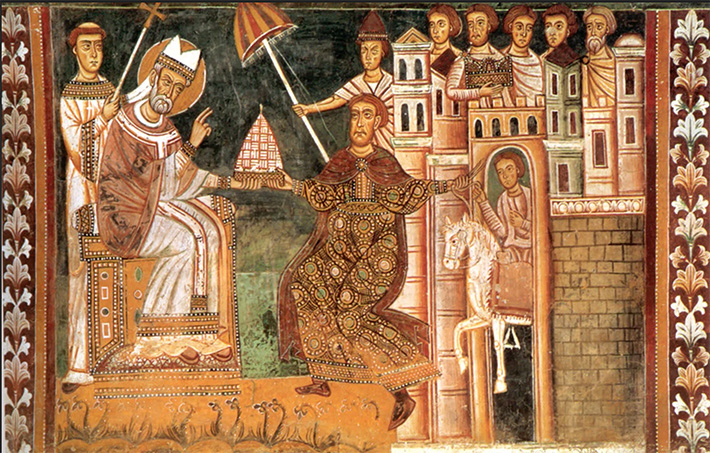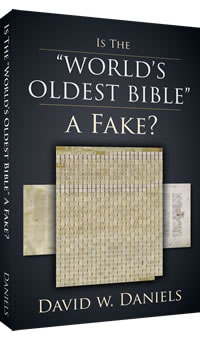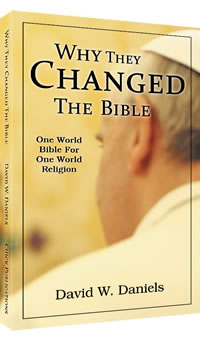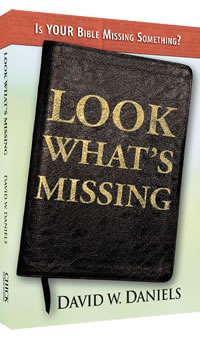The Catholic Church was Built on Forgeries

13th-century fresco depicting the “Donation” of Constantine
For centuries, monarchs, presidents, and world leaders have made pilgrimages to the Pope, seeking his blessing over their reigns. But why does the Pope wield such immense power? Where did this authority come from? It all goes back to a forged document that granted the Pope control over kingdoms and churches—and forever altered the course of history.
The “Donation” of Constantine
The Donation of Constantine is a document that supposedly came from Emperor Constantine in the 4th century, granting the Pope control over vast territories in the Western Roman Empire. It made Rome the seat of papal power and declared the Pope supreme in both spiritual and political matters. It instantly gave the Vatican unparalleled control over Christian kingdoms, ensuring papal dominance for centuries.
During the Middle Ages, the Catholic Church wielded the Donation of Constantine as its primary weapon to justify its authority and expand its influence. Popes used it to assert their control over European monarchs, increasing their territorial holdings and expanding their political reach. For centuries, the Vatican used this document as proof of its divine right to rule. But there was just one problem: the Donation of Constantine was a forgery. In fact, Cardinal Caesar Baronius, in his “Ecclesiastical Annals” (l. 1538-1607), admitted it was a forgery.
The Great Reveal
In the 15th century, scholars began to scrutinize the Donation of Constantine. Upon deeper investigation, it became clear that the document had been forged, likely by a scribe working for the papacy in the 8th century. The language, historical inaccuracies, and the complete absence of any mention in early Christian writings didn’t add up. The document was clearly an invention, used to manipulate the political and religious landscape to benefit the Vatican and its leaders.
Despite this revelation, the damage had already been done. The papacy had used the Donation of Constantine to consolidate power, its influence seen to this very day.
The Vatican’s Sinister Role in Bible Translations
Fast forward to modern times, and we find another form of questionable authority emerging from the Catholic Church—its influence over Bible translations. Two manuscripts, Sinaiticus and Vaticanus, have played a significant role in shaping modern translations of the Bible. These manuscripts are central to the Catholic Church's version of Scripture and are used by modern Bible "scholars" in creating translations like the New International Version (NIV), the English Standard Version (ESV), the New American Standard Bible (NASB), and many others.
The Sinaiticus manuscript is highly revered by the Catholic Church and is promoted as being one of the most ancient and reliable sources of the Bible. However, if the Catholic church forged documents in a power grab before, could they have done it a second time?
Sinaiticus—Not What You Think
Sinaiticus is often called one of the "oldest and best" manuscripts of the Bible. It’s praised for its early origins and considered a treasure by the Catholic Church. But what if it’s not as ancient or authentic as they claim?
David W. Daniels has uncovered shocking evidence that proves the Sinaiticus is, in fact, a modern forgery. Using modern technology, Daniels examined the manuscript and found several glaring issues—like uneven aging, coloration inconsistencies, and textual errors—that show the manuscript is far newer than originally believed. In fact, Daniels demonstrates that the Sinaiticus was created to serve a very specific purpose: to challenge the authority of traditional manuscripts used for the King James Bible.
Just like the Donation of Constantine, the Sinaiticus is part of a larger agenda—a deliberate attempt to manipulate Scripture and reshape biblical truth.
A Tale as Old as Time
The Donation of Constantine was the first major forged document used by the Catholic Church to grant the Vatican absolute power. The forgery of the Sinaiticus manuscript represents a modern continuation of tactic. Whereas the Donation of Constantine secured the Vatican’s political dominion, forged biblical manuscripts grant influence over modern Bible translations.
These two forgeries serve as a powerful reminder to be vigilant against the tactics used by those who seek to change and undermine the truth of Scripture. God’s Word must be preserved and protected. That’s why we hold fast to the truth as it has been delivered to us in the pure and preserved word of God, the King James Bible.
- See more articles on related topics:
- Bible Versions
- Political Power
- Papacy
- Sinaiticus
- Modern Versions
Products of interest:
-

Is The "World's Oldest Bible" a Fake?
352 pages
Here is proof that the Sinaiticus, a supposedly ancient Bible text on which modern Bibles are based, is actually a 19th-century fake. -

Who Faked the "World’s Oldest Bible"?
448 pages
The crime is fraud, and you’re the detective! If the devil has cooked up a plot against your Bible, would you want to know it? In this book, you'll discover the evidence that reveals a much larger plot. -

Why They Changed the Bible
228 pages
See who is behind the gradual changing of modern Bibles. There’s no guessing about what these people believe. They will tell you, in their own words! -

Look What's Missing!
256 pages
For years, publishers have been removing words, and even whole verses, from modern Bibles. What's missing from your Bible? Take a look! -

Did the Catholic Church Give Us the Bible?
208 pages
The Bible has two histories. One is of God preserving His words through His people. The other is of the devil using Roman Catholic "scholars" to pervert God’s words and give us corrupt modern Bibles. -

New King James - The Bridge Bible
It is NOT a King James Bible! It promised to be a 5th edition of the KJV, preserving "the originally intended meaning of every verse." But that's not what happened.
